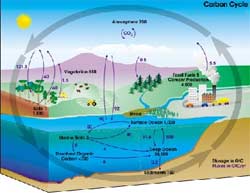Imagine a gigantic, inflatable, sausage-like bag capable of storing 160 million tonnes of CO2 - the equivalent of 2.2 days of current global emissions. Now try to picture that container, measuring up to 100 metres in radius and several kilometres long, resting benignly on the seabed more than 2 Miles below the ocean's surface and staying there forever. That would offer a way of storing carbon dioxide permanently and thus help in the fight against climate change.
At first blush, this might appear like science fiction, but it's an idea that gets serious attention from Dr. David Keith, one of Canada's foremost experts on carbon capture and sequestration. Keith will talk on the subject at the 2008 Annual Conference of the American Association for the Advancement of Science in Boston at a session entitled "Ocean Iron Fertilization and Carbon Sequestration: Can the Oceans Save the Planet?"
Shooting rockets full of sulphur into the high atmosphere to emulate the cooling effect of volcanic eruptions, launching space mirrors, making artificial reflective clouds, or building costly synthetic trees - there are a lot of gee-whiz (and risky) "geo-engineering" ideas for dealing with global warming that are really silly, remarks Keith, an NSERC grantee and director of the Energy and Environmental Systems Group at University of Calgary-based Institute for Sustainable Energy, Environment and Economy. At first glance his own idea looks nutty, but as one looks closer it seems that it might technically feasible with current-day technology. But, adds Keith, who holds the Canada Research Chair in Energy and the Environment, it's early days and there is not yet any serious design study for the concept.
The original idea of ocean storage was conceived several years ago by Dr. Michael Pilson, a chemical oceanographer at the University of Rhode Island, but it really took off last year when Keith confirmed its feasibility with Dr. Andrew Palmer, a world-renowned ocean engineer at Cambridge University. Keith, Palmer and another scientist at Argonne National Laboratory later advanced the concept through a technical paper prepared for the 26th International Conference on Offshore Mechanics and Arctic Engineering in June 2007.
Keith sees this solution as a potentially useful complement to CO2 storage in geological formations, particularly for CO2 emanating from sources near deep oceans. He believes it may offer a viable solution because vast flat plains cover huge areas of the deep oceans. These abyssal plains have little life and are benign environments. Abyssal plains are flat or very gently sloping areas of the deep ocean basin floor, covering approximately 40% of the ocean floor and reaching depths between 2,200 and 5,500 m (7,200 and 18,000 ft). They generally lay between the foot of a continental rise and a mid-oceanic ridge.

